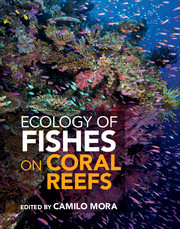Book contents
- Frontmatter
- Contents
- Preface
- Foreword
- List of contributors
- PART I BASIC ECOLOGY
- PART II PATTERNS AND PROCESSES
- PART III HUMAN FINGERPRINTS
- PART IV CONSERVATION
- PART V DEBATES AND PARADIGM SHIFTS
- 23 Is dispersal of larval reef fishes passive?
- 24 Density dependence and independence and the population dynamics of coral reef fishes
- 25 Equilibrial versus non-equilibrial dynamics in coral reef fishes
- 26 Cryptic density dependence: integrating supply-side ecology with population regulation
- 27 Priority effects
- 28 Inverted trophic pyramids
- 29 Shifting baselines in coral reef fishes
- 30 Pluralism explains diversity in the Coral Triangle
- 31 Reef fish biogeographical regions
- 32 Size and sex change
- 33 Quantifying reef fishes: bias in observational approaches
- 34 Seascape ecology of fishes on coral reefs
- 35 The future for coral reef fishes
- 36 Perpetual struggle for conservation in a crowded world and the needed paradigm shift for easing ultimate burdens
- References
- Index
23 - Is dispersal of larval reef fishes passive?
from PART V - DEBATES AND PARADIGM SHIFTS
Published online by Cambridge University Press: 05 May 2015
- Frontmatter
- Contents
- Preface
- Foreword
- List of contributors
- PART I BASIC ECOLOGY
- PART II PATTERNS AND PROCESSES
- PART III HUMAN FINGERPRINTS
- PART IV CONSERVATION
- PART V DEBATES AND PARADIGM SHIFTS
- 23 Is dispersal of larval reef fishes passive?
- 24 Density dependence and independence and the population dynamics of coral reef fishes
- 25 Equilibrial versus non-equilibrial dynamics in coral reef fishes
- 26 Cryptic density dependence: integrating supply-side ecology with population regulation
- 27 Priority effects
- 28 Inverted trophic pyramids
- 29 Shifting baselines in coral reef fishes
- 30 Pluralism explains diversity in the Coral Triangle
- 31 Reef fish biogeographical regions
- 32 Size and sex change
- 33 Quantifying reef fishes: bias in observational approaches
- 34 Seascape ecology of fishes on coral reefs
- 35 The future for coral reef fishes
- 36 Perpetual struggle for conservation in a crowded world and the needed paradigm shift for easing ultimate burdens
- References
- Index
Summary
The debate about whether larval reef fishes were passively dispersed began in the 1990s. Before that, larvae were assumed to be passively dispersed over long distances by currents, resulting in open populations over large spatial scales, with little self-recruitment. The debate moved from assumptions based on limited knowledge of the behavior of larvae of temperate species only distantly related to those living on coral reefs, to increased understanding of what larval reef fishes actually do during their pelagic life-history stage, informed by laboratory and in situ research on the behavior of the larvae. Larval reef fishes prove to be remarkably good at swimming and at orientating in the seemingly featureless open waters where they live, and they have good sensory abilities (hearing, smell, vision): in short, they have the ability to strongly influence their dispersal by currents. Increasing evidence that self-recruitment is actually very common in reef fishes, helped resolve the debate. The result was a paradigm change in coral reef fish ecology. Dispersal of coral reef fish larvae is now regarded as a biophysical process strongly influenced by both currents and behavior.
The vast majority of teleost reef fishes have a complex life history that includes a pelagic larval stage [1443], and adults of many species are relatively site attached, so it is movement of the larvae that determines the scale of population connectivity in many of these fishes [577]. This type of life history has major implications for population demography and management, and has therefore, been a major focus for research.
The past 20 years has seen a paradigm shift in reef fish biology. At the start of the 1990s, the near unanimous view was that dispersal of larval reef fishes was a primarily physical process whereby passive, planktonic larval stages were moved around the ocean by currents, and which operated over very large spatial scales leading to open populations [e.g. 2119,2226,2681]. Today, the majority view is that dispersal of larvae takes place over a range of scales, and that larvae of many species have the behavioral capabilities to strongly influence their dispersal trajectories [578,1295].
- Type
- Chapter
- Information
- Ecology of Fishes on Coral Reefs , pp. 223 - 226Publisher: Cambridge University PressPrint publication year: 2015
- 13
- Cited by



